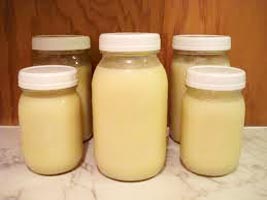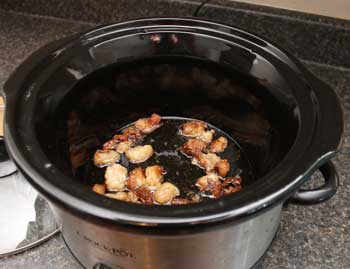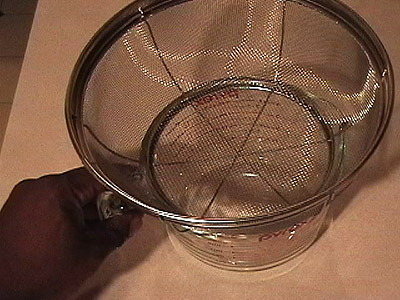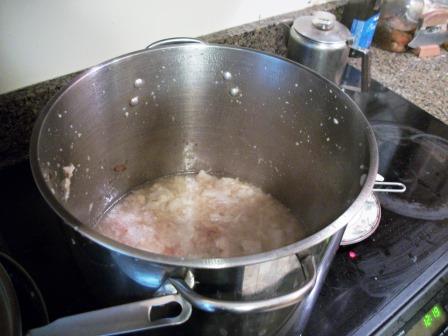6 Easy Beef Tallow-Rendering Steps
6 Easy Steps
How To Render Beef Suet/Fat Into Tallow
Photo Tutorial - Recipe
By Xenia Stavrinides (Rainbow Ranch Farms and Ethical Chicken)
 |
| Photo Credit |
Health Benefits of Cooking with Clean Beef Fat/Suet/Tallow
CLA is not manufactured by the human body, this means that CLA's must be included in the human diet. The best ways to include CLA's into the diet are by consuming clean, high-quality foods such as "vaccine-free, antibiotic-free and tetanus-free" grass-fed/grass-finished beef.
 |
| Photo Credit |
"Tallow is an excellent source of niacin, vitamins B6, B12, K2, selenium, iron, phosphorus, potassium and riboflavin. Grass fed beef tallow contains high ratio of conjugated linoleic acid (CLA) which is a cancer-resistant agent. Contrary to the popular conception, tallow is good for health as tallow fat is similar to the fat/muscles in the heart. Recent studies have shown that human beings need at least 50% of saturated fats like tallow and lard to keep the heart pumping hard and healthy." Source: Beeftallow.com
Grass fed beef fat contains natural fat metabolizing elements often referred to as CLA (Conjugated Linoleic Acid). In scientific studies, CLA's has been shown to reduce body fat, help increase absorption of Vitamin A, keeps small fat cells from increasing in size, increase lean muscle mass, and according to Dr. Mercola "CLA helps fight 5-lipox and AA inflammation without harming your arteries. CLA does this by converting inside your body to both DHA and EPA, both of which have powerful anti-inflammatory properties. Source: Mercola.com
CLA's have been scientifically proven to lower cancer risk, help fight against Breast cancer and shrink tumor mass: Source: jn.nutrition.org
CLA's have been shown in studies to have therapeutic, anti-inflammatory effects, improving human gut bacteria and may even reduce the symptoms of inflammatory bowel diseases (IBD) such as ulcerative colitis and Crohn’s. "(Both usually involve severe diarrhea, pain, fatigue and weight loss. IBD can be debilitating and sometimes leads to life-threatening complications.)" Source: Mayoclinic.org
CLA's Have been linked to:
 |
| Photo Credit |
Home Rendered Fat vs. Store Bought Rendered Fat
Commercially manufactured tallow and lard is made with additives, stabilizers, preservatives and is a hydrogenated fat that has been shown to be a leading cause of immune-system damage, similar to vegetable fats/oils. According to Wikipedia: "Industrially-produced lard, including much of the lard sold in supermarkets, is rendered from a mixture of high- and low-quality fat sourced from throughout the pig.[9] Lard is often hydrogenated to improve its stability at room temperature. Hydrogenated lard sold to consumers typically contains fewer than 0.5 g of transfats per 13 g serving.[10] Lard is also often treated with bleaching and deodorizing agents,emulsifiers, and antioxidants such as BHT.[4][11] These treatments make it more consistent and prevent spoilage. (Untreated lard must be refrigerated or frozen to prevent rancidity.)[12][13]" Source: Wikipedia
---------------------------------------------------------------------------------------------------------------------------------
**NOW, LET'S MAKE NUTRITIOUS, DELICIOUS BEEF TALLOW**
 |
| Photo Credit |
What You Will Need
High quality beef fat/suet from a clean (vaccine-free, antibiotic-free, tetanus-free) bull, heifer or cow that has been 100% grass-fed and grass-finished. It is best to render beef fat from a non-castrated (no steers) source, one that has grazed/grass-fed/pastured for at least 4 years.
Some people claim that the fat around the kidneys is best, however balanced ratios of fat/suet from around the entire carcass is the very best for Omega-3/6 fat balance. Tallow that contains a wide spectrum of vitamins, good fats and nutrients is the most beneficial.
Large stock pot
Slow cooker
Wooden spoon
1/2 cup reverse osmosis water
Clean glass wide mouth jars w/lids (for storage)
Strainer
Towel
Sharp Knife
Some people claim that the fat around the kidneys is best, however balanced ratios of fat/suet from around the entire carcass is the very best for Omega-3/6 fat balance. Tallow that contains a wide spectrum of vitamins, good fats and nutrients is the most beneficial.
Large stock pot
Slow cooker
Wooden spoon
1/2 cup reverse osmosis water
Clean glass wide mouth jars w/lids (for storage)
Strainer
Towel
Sharp Knife
Instructions (what my process is)
After butchering, we place the entire carcass in the cooler for 24/hours.The next day, I trim fat from around the carcass and cut fat into small cubes,
trying to remove all the excess meat and anything else I don't want in the fat-grind
Sometimes I run the fat through the grinder to get it into very small, fat-grindings (like ground pork, g-beef, g-lamb and similar).
You do not have to grind it, you could just cut the fat into very small chunks.
Using a large stainless steel stock-pot, I fill it with the small chunks or fat/suet-grind
Using the very lowest flame setting, I start the melting process (while stirring to prevent burn)
Adding about 1/2 cup of reverse osmosis water and stir (water optional)
Get it started over an open stove-top flame for about 30/minutes (occasionally stirring to prevent the fat from sticking or burning)
If you do not have a slow cooker, use the double-boiler method. Use a stock pot that fits inside another stock pot. Fill the stock pot that is making contact with the flame about 1/3 with water, then place the stock pot containing the suet, inside the pot that contains water (it will float in the water). I use a floating-in-water method. The video below explains a steam-only double boiler method.
Video below: How to fake a double boiler.
I then transfer all the fat and liquids into a pre-warmed slow cooker (lowest setting)
OPTION: double boiler instead of slow cooker.
OPTION: double boiler instead of slow cooker.
 |
| Photo Credit |
As fat melts, everything else will rise and float to the top
Depending on the heat setting and the amount of fat to be rendered, time will vary. I don't worry about the time factor since I consider the fat melted when the clear fat liquid has completely separated from any little small crispy pieces. Note: Large batches can take 2-3 days.
TIP: Leave the slow cooker lid slightly cracked, to vent. This prevents overflow and spills.
 |
| Photo Credit |
I strain the liquid tallow through a stainless steel "fine" strainer to catch all the little pieces and chunks. Straining into a large glass or stainless steel bowl makes this easier for me.
 |
| Photo Credit |
To make medicinal, herbal or flavored tallow/lard "Click Here For Details".
I do this before pouring into jars. I usually make a variety of tallow/lard, ranging from plain to medicinal.
I do this before pouring into jars. I usually make a variety of tallow/lard, ranging from plain to medicinal.
Finally I carefully pour the liquid tallow into wide-mouth, glass jars.
Sometimes, when I make extra (to share), I pour into small molds or I use the 8oz glass (wide mouth) jars.
 |
| Photo Credit |
OPTIONS:
To use a softer tallow over the course of 5 days, leave a jar in a cool dark place on the kitchen counter.
To store tallow for over 5 days, refrigerate/cool to 40(f) degrees (up to 3 months).
To store tallow for longer than 3 months, fill wide-mouth jar, leaving 2" from the top, make sure the lid is tight and freeze (up to 1 year).
NOTE: To prevent decomposition, keep tallow in an airtight container. This also prevents oxidation.
 |
| Photo Credit |
How To Use Tallow
I use tallow (or rendered lard) anytime I apply any heat to any foods (soups, stock, broth, frying, baking, slow cooker etc.). Tallow (like lard) is a very stable fat, especially under high-heat (420 (f) degrees), and the fat does not turn rancid when high heat is applied. This is another reason why cooking with tallow/lard is beneficial, especially to those who are concerned about damages caused from free radicals, which are known to cause cancer, disease and illness.
 |
| Photo Credit |
I cook using tallow (or lard) for many reasons. High quality tallow (like lard) contains beneficial nutrients that my body does not manufacture, and this is one of the several ways I choose to balance my essential Fatty Acid requirements. Cooking with tallow (or lard) also helps my body absorb more Vitamins A, E, K and D. In addition I use tallow and lard to make soap, bird-seed blocks and personal skin and hair care products.
 |
| Photo Credit |
Please Refer to These Additional Sources, Links and Research Materials:
Advance Health Natural Health Advisory
NTP Talk Rainbow Ranch Farms
Naturopathy Digest Ny Times
Ethical Chicken The American Journal of Clinical Nutrition
NPR Kelley Beef
Dr. Oz Doc Slide
Rekha Mankad, M.D. BioMed Central Link 2:
The UK Independent Mother Earth News
MSKCC.org Patents






Hi,My name is Makoto,I am the chef and run a restaurant in New York.I was looking for a good quality tallow and happened to see your site.Looks great,nutritious and sanitary.Is it possible to get some from your farm?
ReplyDelete